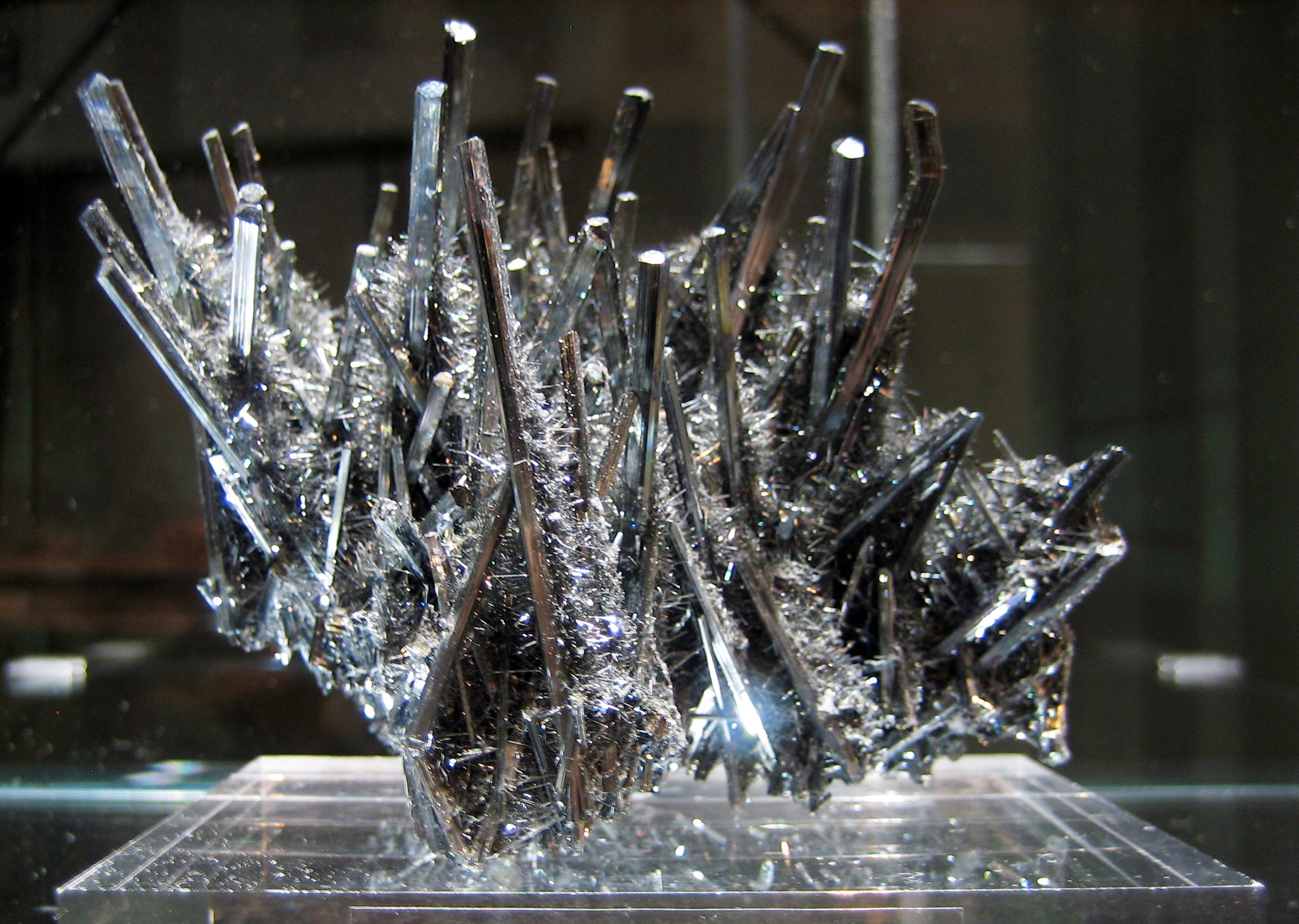- Stibnite
Infobox mineral
name = Stibnite
category =
boxwidth =
boxbgcolor =

caption = Stibnite in the Carnegie Museum of Natural History
formula =antimony sulfide (Sb2S3)
molweight =
color = Steel gray to dull gray. Blackiridescent tarnish may be present
habit = Massive, radiating and elongated crystals. Massive and granular
system = Orthorhombic
twinning =
cleavage = Perfect
fracture = Small-scale subconchoidal
mohs = 2
luster = Splendent on fresh crystals surfaces, otherwise metallic
refractive = Opaque
opticalprop =
birefringence =
pleochroism =
streak = Similar to color
gravity = 4.56 - 4.62
melt =
fusibility =
diagnostic =
solubility = decomposed withhydrochloric acid
diaphaneity =
other =
var1 = Metastibnite | var1text = Earthy, reddish depositsStibnite, sometimes called antimonite, is a
sulfide mineral with the formula Sb2S3. This soft grey material crystallizes in anorthorhombic space group. It is the most important source for themetaloid antimony . [Sabina C. Grund, K. Hanusch, H. J. Breunig, H. U. Wolf, “Antimony and Antimony Compounds” in Ullmann’s Encyclopedia of Industrial Chemistry 2006, Wiley-VCH, Weinheim. DOI|10.1002/14356007.a03 055.pub2] The abbreviation for antimony, Sb, is taken from stibnite.Formation, structure, reactivity
Sb2S3 forms when antimony(III) compounds are treated with
hydrogen sulfide . This reaction gives a black precipitate::2 Sb3+ + 3 H2S → Sb2S3 + 6 H+This reaction is reversed byhydrochloric acid .Stibnite is attacked by potassium hydroxide solution and dissolves in solutions of
polysulfide ions to give polysulfido complexes. [Martin, T. M.; Schimek, G. L.; Pennington, W. T. and Kolis, J. W., "Synthesis of Two New Antimony Sulfide Clusters: Structures of [PPh4] 2 [Sb6S6] and [PPh4] 2 [Sb4S6] ", Journal of the Chemical Society, Dalton Transactions 1995, 501-2.] Related reactions were once used in university courses onqualitative inorganic analysis .Stibnite has a structure similar to that of arsenic trisulfide, As2S3. The Sb(III) centers, which are pyramidal and three-coordinate, are linked via bent two-coordinate sulfide ions.
Uses
Stibnite has no significant uses, except as a precursor to antimony oxide, which is the most commonly marketed form of antimony. In ancient times, it was used as
mascara called kohl.Antimony trisulfide finds use in
pyrotechnic composition s, namely in the glitter and fountain mixtures. Needle-like crystals, "Chinese Needle", are used in glitter compositions and whitepyrotechnic star s. The "Dark Pyro" version is used inflash powder s to increase their sensitivity and sharpen their report. It is also a component of modernsafety match es. It was formerly used in flash compositions, but its use was abandoned due to toxicity and sensitivity tostatic electricity . [http://www.pyrouniverse.com/chem.htm]Occurrence
Small deposits of stibnite are common, but large deposits are rare. It occurs in
Canada ,Mexico ,Peru ,Japan ,China ,Germany ,Romania ,Italy ,France ,England ,Algeria , andKalimantan ,Borneo . In theUnited States it is found inArkansas ,Idaho ,Nevada ,California , andAlaska . Large iridescent stibnite crystals are found in Japan.Fact|date=May 2007As of May 2007, the largest specimen on public display (1000 pounds) is at the
American Museum of Natural History . [cite web| url =http://www.amnh.org/science/papers/stibnite.php | title=American Museum of Natural History, Spectacular Stibnite| publisher=American Museum of Natural History |accessdate=2007-05-27] [ [http://www.cctv.com/program/cultureexpress/20070406/100505.shtml 1000 Pound Stibnite!!] ]See also
*
List of minerals References
Wikimedia Foundation. 2010.
